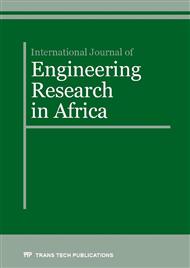p.1
p.9
p.17
p.26
p.35
p.44
p.57
p.64
p.71
Suitability of Nigerian Bentonite in Drilling Fluid Formulation
Abstract:
The oil production industry in Nigeria operates both onshore and more recently offshore in the coastal areas located in the oil-rich Niger-Delta. Unfortunately, the drilling mud additives currently used in the country are all imported and at huge foreign exchange costs. Therefore the objective of the current effort is development of drilling fluid from locally sourced mud additives for drilling operations. Various rheological and filtration tests were carried out on both unbeneficiated and beneficiated local clay from Afuze, Nigeria using a six-speed Rheometer and API filter press respectively. Beneficiation involved the addition of sodium carbonate, caustic soda and starch to the mud formulations.Clay concentrations were varied from 20g/350ml to 60g/350ml. The test results showed that free swell volume (FSV) increased from with clay concentration with the optimum values observed at 60g/350ml. The filtrate loss of 63ml, filter cake thickness of 6m, yield point of 7cp and plastic viscosity of 1cp values of Afuze clay did not satisfy API specification of 15ml, 2m, 24cp and 8cp respectively at any tested concentration. Likewise Afuze clay did not display gel strength (10 seconds and 10 minutes of 29 and 34 respectively) suitable for bringing cuttings up from the hole. However, improvements in its rheological and filtration properties as well as free swell volume were observed with the beneficiated Afuze clay at clay concentrations of 20, 30, 40, 50, 60g/350ml when beneficiated with starch concentrations of 1g and 0.5g, sodium carbonate of 2g and 1g and caustic soda of 0.25g. Beneficiated Afuze clay displayed gel strengths (10 seconds and 10 minutes of 98 and 140 respectively) suitable for bringing cuttings up from the hole with optimum values observed at 60g/350ml.
Info:
Periodical:
Pages:
26-34
Citation:
Online since:
June 2016
Keywords:
Price:
Сopyright:
© 2016 Trans Tech Publications Ltd. All Rights Reserved
Share:
Citation:


